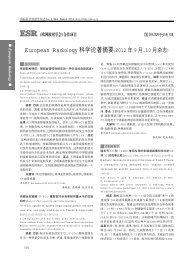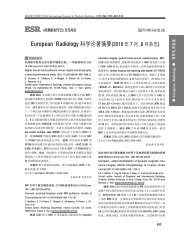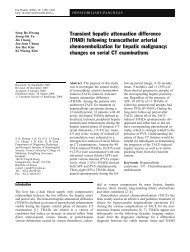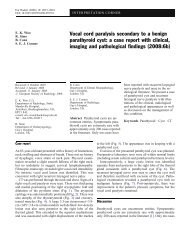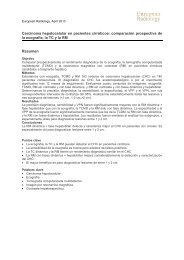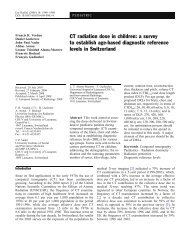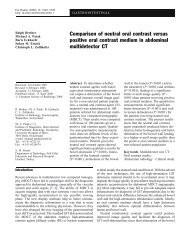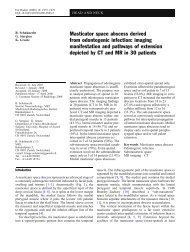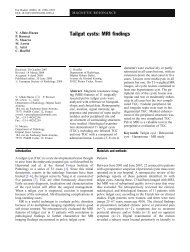Value of comprehensive renal ultrasound in children with acute ...
Value of comprehensive renal ultrasound in children with acute ...
Value of comprehensive renal ultrasound in children with acute ...
You also want an ePaper? Increase the reach of your titles
YUMPU automatically turns print PDFs into web optimized ePapers that Google loves.
2982<br />
changes [4–7]; currently DMSA sc<strong>in</strong>tigraphy is considered<br />
the gold standard (i.e., the reference <strong>in</strong>vestigation) for the<br />
diagnosis <strong>of</strong> aPN and <strong>renal</strong> scarr<strong>in</strong>g [8–10]. Contrastenhanced<br />
spiral CT has been reported to be an efficient<br />
diagnostic tool, but is reluctantly used <strong>in</strong> <strong>children</strong> due to its<br />
high radiation burden [11, 12]. Both DMSA and particularly<br />
CT studies have the disadvantage <strong>of</strong> ioniz<strong>in</strong>g radiation<br />
exposure and <strong>in</strong>travenously <strong>in</strong>jected agents. Additionally,<br />
they are relatively expensive, and DMSA is not available at<br />
night hours and dur<strong>in</strong>g the weekend <strong>in</strong> some areas. MRI is<br />
also highly effective, but the rout<strong>in</strong>e use is h<strong>in</strong>dered by the<br />
high costs, its restricted availability, and the need for<br />
sedation <strong>in</strong> small <strong>children</strong> and <strong>in</strong>fants [13].<br />
Ultrasound (US) is widely available, <strong>in</strong>expensive, and <strong>in</strong><br />
general the first imag<strong>in</strong>g study performed <strong>in</strong> <strong>children</strong> <strong>with</strong><br />
suspected UTI, though availability <strong>of</strong> reliable high-quality<br />
US is also restricted. However, greyscale US is reported to<br />
be poor <strong>in</strong> detection <strong>of</strong> <strong>renal</strong> <strong>in</strong>volvement [1]. More than a<br />
decade ago amplitude-coded color Doppler sonography<br />
(aCDS), also called “power Doppler,” was <strong>in</strong>troduced. It<br />
has a higher sensitivity to low-flow velocities even at high<br />
<strong>in</strong>solation angles (provided sufficient flow volume, as<br />
encountered <strong>in</strong> the peripheral <strong>renal</strong> parenchyma) [14].<br />
Also, aCDS has successfully been used for assessment <strong>of</strong><br />
particularly focal or segmental <strong>renal</strong> perfusion alteration<br />
[15]. Most pyelonephritic lesions have an ischemic component<br />
or exhibit associated perfusion disturbances, <strong>with</strong> a<br />
reportedly higher sensitivity <strong>of</strong> aCDS for the detection <strong>of</strong><br />
(focal) aPN [16, 17]. However, all these studies focus<br />
exclusively on the use <strong>of</strong> aCDS, not <strong>in</strong>clud<strong>in</strong>g additional<br />
<strong>in</strong>formation retrieved from greyscale US that may also be<br />
beneficial for the diagnos<strong>in</strong>g upper UTI.<br />
The aim <strong>of</strong> this retrospective analysis was to evaluate if<br />
comb<strong>in</strong><strong>in</strong>g <strong>renal</strong> greyscale US and aCDS f<strong>in</strong>d<strong>in</strong>gs may<br />
improve US potential for depiction <strong>of</strong> upper UTI <strong>in</strong> <strong>in</strong>fants<br />
and <strong>children</strong> compared to (1) DMSA sc<strong>in</strong>tigraphy and (2)<br />
f<strong>in</strong>al diagnosis.<br />
Materials and methods<br />
The picture archiv<strong>in</strong>g and communication system <strong>of</strong> our<br />
hospital was used to retrospectively identify pediatric<br />
patients <strong>with</strong> <strong>acute</strong> UTI who underwent <strong>comprehensive</strong> US<br />
(i.e., <strong>in</strong>clud<strong>in</strong>g aCDS) and DMSA for the assessment <strong>of</strong><br />
<strong>renal</strong> <strong>in</strong>volvement. Patients <strong>with</strong> congenital abnormalities,<br />
hydronephrosis, recurrent UTI, known vesico-ureteral<br />
reflux (VUR), or scars were excluded.<br />
Tc 99m DMSA sc<strong>in</strong>tigraphy was performed us<strong>in</strong>g a<br />
standard protocol accord<strong>in</strong>g to the guidel<strong>in</strong>es on <strong>renal</strong><br />
cortical sc<strong>in</strong>tigraphy <strong>in</strong> <strong>children</strong> <strong>with</strong> UTI <strong>of</strong> the European<br />
Association <strong>of</strong> Nuclear Medic<strong>in</strong>e [18]. Two to three hours<br />
after <strong>in</strong>travenous <strong>in</strong>jection <strong>of</strong> 80 μCi/kg (2,92 MBq/kg),<br />
planar anterior, posterior, and right as well as left oblique<br />
images <strong>of</strong> the kidneys were obta<strong>in</strong>ed us<strong>in</strong>g an ELSCINT<br />
Helix dual-head camera (GE Medical Systems, Milwaukee,<br />
WI); s<strong>in</strong>ce 2002 some patients were exam<strong>in</strong>ed us<strong>in</strong>g a E.<br />
CAM dual-head device (Siemens Medical Solutions,<br />
Erlangen, Germany). Images were obta<strong>in</strong>ed for 300,000<br />
to 500,000 counts on a 256×256 matrix. The consensus<br />
criteria <strong>of</strong> the International Radionuclides <strong>in</strong> Nephrourology<br />
Group were used for <strong>in</strong>terpretation <strong>of</strong> DMSA results<br />
[18]. The sc<strong>in</strong>tigraphic diagnosis <strong>of</strong> an “upper UTI” was<br />
def<strong>in</strong>ed by totally or partially reversible lesions on DMSA;<br />
if the first DMSA exam<strong>in</strong>ation was abnormal, the exam<strong>in</strong>ation<br />
was repeated after 6 and 12 months. A specialist <strong>in</strong><br />
nuclear medic<strong>in</strong>e <strong>in</strong>dependently read the images. No<br />
SPECT studies were performed for radiation protection<br />
issues.<br />
Comprehensive US was performed us<strong>in</strong>g an Acuson<br />
Sequoia 512 Ultrasound device (Acuson/Siemens, Mounta<strong>in</strong><br />
View, CA) <strong>with</strong> various curved array and/or l<strong>in</strong>ear multifrequency<br />
transducers (1–14.0 MHz). Initially, a thorough<br />
greyscale US study was performed. This always started <strong>with</strong><br />
the sufficiently filled ur<strong>in</strong>ary bladder after physiological<br />
hydration <strong>of</strong> the patient, <strong>in</strong>cluded a view <strong>of</strong> the posterior<br />
urethra, and cont<strong>in</strong>ued <strong>with</strong> the kidneys [19]. Subsequently,<br />
aCDS was applied manipulat<strong>in</strong>g <strong>of</strong> color ga<strong>in</strong> until noise<br />
become apparent. Frequency, gate, filter, scale, and persistence<br />
were optimized to visualization <strong>of</strong> the peripheral<br />
<strong>in</strong>tra<strong>renal</strong> vasculature, keep<strong>in</strong>g the focus zone <strong>in</strong> the lower<br />
third <strong>of</strong> the color box. Both axial and longitud<strong>in</strong>al scans were<br />
obta<strong>in</strong>ed to provide a vascular map <strong>of</strong> the kidneys. In each<br />
patient both kidneys-when present-were assessed us<strong>in</strong>g the<br />
healthy kidney for comparison; <strong>in</strong> patients <strong>with</strong> bilateral<br />
disease, the spleen was used for <strong>in</strong>tra<strong>in</strong>dividual comparison.<br />
In all kidneys the largest amount <strong>of</strong> depictable vasculature<br />
throughout the entire kidney was assessed <strong>in</strong> either prone or<br />
sup<strong>in</strong>e position. Criteria for aPN diagnosis on greyscale US<br />
<strong>in</strong>cluded changes such as mild dilatation <strong>with</strong> thickened<br />
pelvic wall and <strong>in</strong>creased echogenicity <strong>of</strong> the <strong>renal</strong> s<strong>in</strong>us as<br />
well as nephromegaly (Fig. 1a, b), and triangular hyperechogenicities<br />
or round hypo-echoic areas (Fig. 2a, b) [20].<br />
On aCDS, the presence <strong>of</strong> any zone <strong>of</strong> decreased or absent<br />
flow <strong>in</strong> the parenchyma (compared <strong>with</strong> other parts <strong>of</strong> the<br />
same kidney at the same depth) was considered <strong>in</strong>dicative for<br />
aPN, provided it could be demonstrated <strong>in</strong> two planes<br />
(Fig. 3). No patient was sedated. Special manoeuvres such as<br />
breath-holds were performed <strong>in</strong> older patients capable <strong>of</strong><br />
cooperation. All US exam<strong>in</strong>ations were performed either by<br />
pediatric radiologists or specially tra<strong>in</strong>ed pediatric surgeons.<br />
In case <strong>of</strong> repetitive US studies, the exam<strong>in</strong>ation closest to<br />
the DMSA scan was used for analysis. Repeated studies as<br />
well as duplex Doppler velocity measurements and <strong>in</strong>ter-/<br />
<strong>in</strong>tra-observer variability have not been evaluated.<br />
Orig<strong>in</strong>al readers <strong>of</strong> US did not know the result <strong>of</strong> any<br />
other imag<strong>in</strong>g modalities, as US was generally the first<br />
exam<strong>in</strong>ation performed. For image review, the US readers<br />
were bl<strong>in</strong>ded to all other imag<strong>in</strong>g results and used the<br />
captured and stored US images available on PACS. DMSA<br />
exam<strong>in</strong>ations were read based on anatomical <strong>in</strong>formation<br />
obta<strong>in</strong>ed from US, as demanded by the guidel<strong>in</strong>es.



